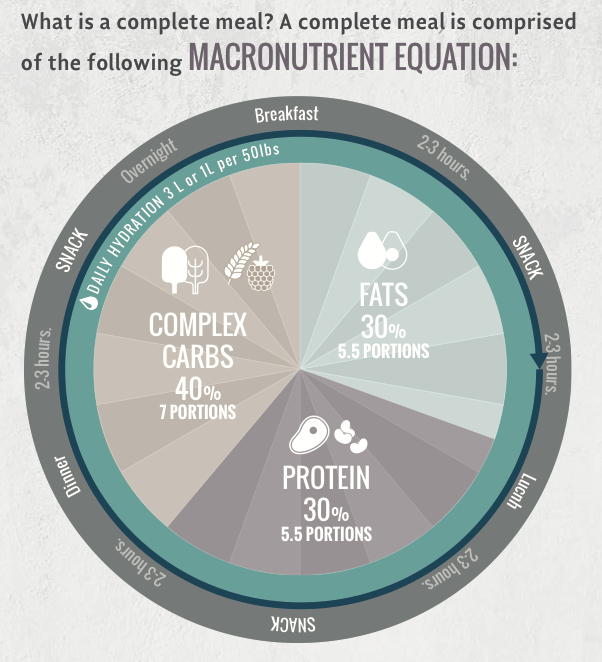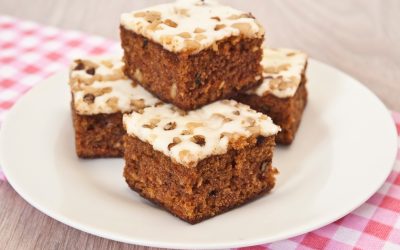Short on time? Jump to:
How to build fats, proteins, and carbs into every meal, every time!
Confused about how to incorporate fats, protein and complex carbs into every meal? You are not alone. Although I do my best to teach about macronutrients and their role on your dinner plate, many still struggle with how to do it properly.
See also: Why Do Fats Get a Bad Rap?
Questions constantly arise like, “what is a balanced meal?” or “what are the macronutrients?”
I may be to blame. I have assumed too much. In today’s food environment, with information coming from every corner and food options to satisfy even the most demanding palate, it is even more challenging to answer the question of what to eat. I didn’t stop to think that information overwhelm may have caused you to miss out on the basics of macronutrients.
I stumbled on this problem when working with a coaching client. I asked how she was doing with incorporating the six smaller meals per day into her busy life. She began to sob. Ultimately I had thrown so much information at her, she became overwhelmed and threw up her hands in frustration. The problem? She didn’t know what the macronutrients were and how to include them in a properly balanced meal.
This was a case of the student teaching the teacher. I had a huge ‘ah-hah!’ moment. I was contributing to the overwhelm state of mind, by assuming you knew. Maybe we need a quick refresher.
The ‘Coles notes’ of macronutrients (not copied from Coles’ notes) is as follows:
- there are three macronutrients: fat, protein and carbohydrate
- water, although not a macronutrient, should be considered as one, in my opinion
- carbohydrates can be simple or complex
- all 3 macros are required, in balance, for an optimally well body
- the Eat Clean® way of eating focuses on including the macros in every meal
- minerals and vitamins are considered micronutrients, and although not eaten in quantity, are essential to optimal wellness

The ratio at which we eat fat, protein, and carbs is: 30% protein + 30% fat + 40% carbohydrates.
I break the 40% carbohydrate number down to reflect 20% green carbs + 20% fruit, fermented dairy and grain carbs.
At any given time then, when considering your dinner plate, try to visualize where your food choices fit on that plate.
The Smoothie Example
You have decided to make a smoothie for breakfast.
You have chosen a banana, cherries, vanilla yogurt, chia and hemp seeds and coconut oil as your base ingredients.
Here is how they align with the Macronutrient Ratio formula:
Recipe is for one serving.
Your Smoothie Recipe
- 1 Banana: Simple Carb
- 1/2 cup cherries: Simple Carb
- 1/2 cup low fat Vanilla yogurt: Protein
- 1 Tbsp flax seeds: Fat
- 1 Tbsp coconut oil: Fat
- 1 – 2 cups water: hydration
This recipe contains:
- 1/2 cup protein (but it is sweetened and is low fat)
- 1/8 cup fat
- 1 1/2 cups simple carbs
Complex carbohydrates are completely missing from this recipe.
Also the ratio is off: 23.5% protein + 6% fat + 70.6% carbohydrates
How To Correct
- 1/2 Banana: Simple Carb ———- less banana, so less simple carbs
- 1/4 cup dark cherries: Simple Carb ———- stays the same
- 2 cups spinach leaves: Complex Carb ———- increases complex carb amount
- 1/2 cup kefir: Protein ———- increases protein & reduces sugar
- 6 Tbsp hemp: Protein ———- further increases protein
- 1 Tbsp coconut oil: Fat ———- increases healthy fat
- 1 Tbsp chia or flax seed: Fat ———- increases healthy fat & fibre
- 1 Tbsp coconut oil: Fat
- 1 avocado: fat ———- increases healthy fat
- 1 – 2 cups water: hydration ———- boosts hydration
This ratio has corrected to: 3/4 cup protein + 3 Tbsp fat + 2 cups complex carbs + 1 cup simple carbs
OR
30% protein + 30% fat + 40% complex carbohydrates
How To Build A Smoothie
1 Banana/avocado/3 Medjool or 6 smaller dates + 1 cup dark fruit cherries/blueberries/raspberries/cranberries/acai/goji (antioxidant factor) + 1 cup light fruit + 2 cups Kale/spinach + 1 cup kefir/Greek yogurt + chia + hemp + cinnamon/turmeric + 1 Tbsp coconut oil
How To Build A Snack
Acceptable combinations: protein + fat + complex carbs
2 Hard boiled eggs + hand full raw vegetables
2 Tbsp hummus + hand full raw vegetables
2 Tbsp natural nut butter + apple
12 raw, unsalted almonds + fruit
How To Build A Meal
Acceptable combinations: protein + fat + complex carbs
4 ounces grilled salmon + 2 cups steamed vegetables drizzled with avocado oil + 1/2 baked sweet potato
4 ounces grilled chicken + 2 cups steamed vegetables drizzled with grass fed butter + 1/2 cup brown rice
1 cup quinoa + 2 cups mixed vegetables sautéed in olive or rice bran oil
Back to my client, her snack problems were most overwhelming to her so I shared my Powerballs recipe and now she is golden. Powerballs contain all three macros and serve to take the edge of morning and afternoon hunger. There is no cooking or baking required. Just combine ingredients in a food processor, roll into balls and eat when hungry.
I hope you have found this helpful.
Wishing you happy macronutrient eating!
Warmly,
Tosca Reno
PS. Learn more about these principles with my FitCommit, FitBoost and 5 Day Winter Juice Cleanse challenge available here.




How would lentils be factored? are they considered to be complex? Also for your smoothie recipe, 1 avocado: the whole thing?
Hi Rehannah,
Thank you so much for your questions.
Both hemp and lentils are considered vegan vegetarian sources of protein.
And if the avo is small then use the whole thing. otherwise cut a big one in half.
oxo,
Tosca
I love this thank you helped me understand how to fit Macro’s in.
Your program sounds like something I’d love to try. However, I get excited until recipes are posted and everyone of them contains a tree nut of some sort. What are those of us allergic to tree nuts supposed to do on these recipes that call for coconut oil or nut snacks or Almond flour?